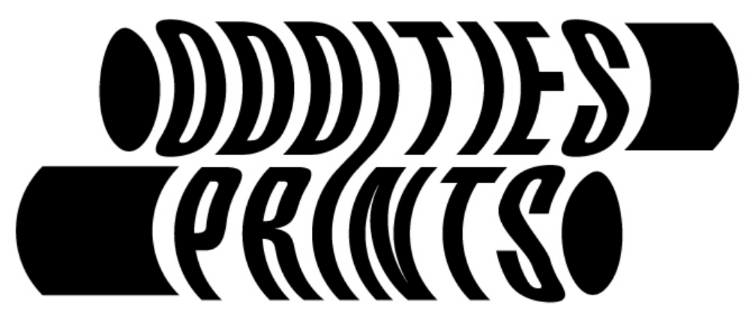Risograph
Oddities is proud to be Kansas City's #1 source for high quality Riso prints. A high speed, low cost alternative to screen printing, this process combines the ink-on-paper look of traditional screen printing with the speed and affordability of Xerox printing, perfect for flyers, books, zines, brochures, artist editions, cards, 7" jackets, cassette & CD covers, and much more. The Risograph process has a few charming idiosyncrasies — check out our guide to Riso printing below and drop us a line to find out if it’s right for your project!
TURNAROUND TIME
For most orders, turnaround is typically 2 weeks after digital proof approval. If you have an upcoming event or desired in-hand date, be sure to share that in your quote request! Rush fees can be calculated upon request.
PRICING
Risograph is our most affordable style of printing, allowing for a balance between budget and quality that other modes of printmaking simply cannot provide. Our competitive pricing is based on the # of colors, quantity, paper weight, and trim size of your order. Additional fees may apply for trimming, folding, binding, or other finishing and/or specialty processes. The larger the print run, the less expensive per-print your job will be.
For a comprehensive quote, please contact us at orders@odditiesprints.com
PAPER SIZE & WEIGHT
We currently can print on stock ranging from 60# text to 65# cover. Our house whites are French Whip Cream and Smart White. We can accomodate other styles and colors of paper with a specialty paper fee. Let us know what you’re looking for in your quote request!
Due to the Riso’s mechanical nature, all prints must include a margin around all edges to prevent the paper from sticking to the machine.
Max Paper Size: Up to 11” x 17”
Required Margin: 3/8”
Recommended Bleed: 1/8”
Maximum Ink Area (no bleed): 10.25” x 16.25”
Maximum Ink Area (full bleed): 10” x 16”
INK COLORS
Risograph uses standardized ink colors that print on a gradient of 0 to 100% coverage. These inks are soy-based and have a translucent quality that allows you to layer several spot colors together using different ink densities to achieve a wide range of colors. Color overprinting can be simulated by using Multiply layer modes in Photoshop, Illustrator, Procreate, etc.
If you are interested in printing a color that we do not offer, our staff may be able to recommend a combination of two or more colors to achieve the look you’re going for! We recommend using no more than four spot colors per print.
Please note: Riso ink is not 100% translucent and layer print order determines the exact degree of overprint. Our Riso operator makes sure to run your prints in a way that best represents your artwork.
FILE SETUP
File Type: PSD, AI, PDF, JPEG, TIFF, or PNG all work! Please submit layered files with each spot color on it’s own layer. Please also include a mockup of what your artwork should look like when all layers are combined. Please use OPACITIES when creating lighter tones. For example: If you need to make “light green”, color your artwork with our GREEN INK color swatch. Then reduce that area to 50% opacity. Do not create a specific “light green” color swatch… doing so may result in those areas printing much darker than your intent ;-)
Overlapping Colors: In addition to using “opacities” when creating each color’s tonal range, make sure to set each layer’s transparency-mode to “multiply”. Doing so will better simulate how Riso’s semi-translucent inks look when printed atop one another
Resolution: 300dpi is ideal. Resolutions of 200-300dpi may also be suitable. For text-based artwork, we recommend vector files with all fonts converted to outlines. For text-based artwork created in photoshop, we recommend 600dpi image resolution.
Color Space: Submit files as RGB, with 0% ink represented as HEX#FFFFFF and 100% ink represented as HEX#000000.
Fonts & Embedded images: Embed all images into the document and outline all vector fonts.
Bleed: Please include 1/8” of bleed on your images. Use one of our templates for artwork setup to be sure you’re accounting for this!
Not sure your file is right? No problem! Send us your files and we'll work with you to get it formatted for Riso!
Any adjustments that exceed standard protocol may incur a pre-press fee.
RISOGRAPH ECCENTRICITIES
Risograph is process with quirks, and there are many moving parts (literally!) that can leave artifacts on prints. We do our best to minimize these quirks by adjusting artwork to be Risograph-friendly when necessary. Still, Risograph is a process of imperfections and we suggest being open to outcome.
GRAIN TOUCH VS HALFTONES
Most folks familiar with Risograph printing are aware of the characteristic Grain Touch texture that it gives artwork. Risographs are also capable of automatically converting artwork into halftones at 43 ppi, 71 ppi, and 106 ppi sizes. All you need to do is let us know what your preference is! We default to Grain Touch unless otherwise specified. With both methods, areas in artwork that include large fields of color are likely to have some spots where coverage is uneven. Texture anomalies may appear most noticeably toward the outer edges of large prints.
For layers with text, we recommend using Grain Touch. For photographs, we recommend using 106ppi or 71ppi halftones. Not sure? We can help!
Roller Marks & Separator Drag
For artwork with more than 2 colors, roller marks may occur in the area shown in blue in this graphic. Paper is fed through the Risograph with a rubber wheel. This applies pressure to fresh ink, which can leave a mark on your artwork. Be mindful of heavy ink coverage in this area! Roller marks that appear in blank margins of the paper can usually be removed with an eraser.
Additionally, a claw-shaped piece of plastic called a separator sits above the paper track. The separator can sometimes drag heavy ink across the center of the paper, denoted by the dotted red line, and create a line through heavy ink coverage.
SMUDGING & OFFSET
Risograph ink is soy-based and non-archival. This type of ink stays “open” many days after printing and will smudge if enough pressure is applied to it. Likelihood of smudges will decrease as the print ages, but will never fully go away. We advise handling your prints by touching only the unprinted areas of the paper. If you plan on handling a large number of prints, we recommend using gloves. Minor smudging can be removed with a rubber eraser.
Ink is most open when leaving the printer. For prints that use heavy ink coverage, there is a chance that ink will offset onto the backs of prints as they stack in the catch tray. We regulate print speed to minimize offset, but we often cannot eliminate it completely, resulting in stray flecks of ink appearing where they shouldn’t. We ship all prints with slip sheets in order to minimizing smudging and offset during transit.
MISREGISTRATION
Each color layer is printed individually, making some degree of misregistration an unavoidable park of the process. Please expect 0–3mm of shift between prints due to press shift and feed rotation. We consider this a part of Riso’s unique charm. We would not recommend Riso for projects that require a large number of tightly registered color layers.
Is any of this of concern to you? Please let us know and we will work with your artwork to ensure these eccentricities don’t distract from your work!










